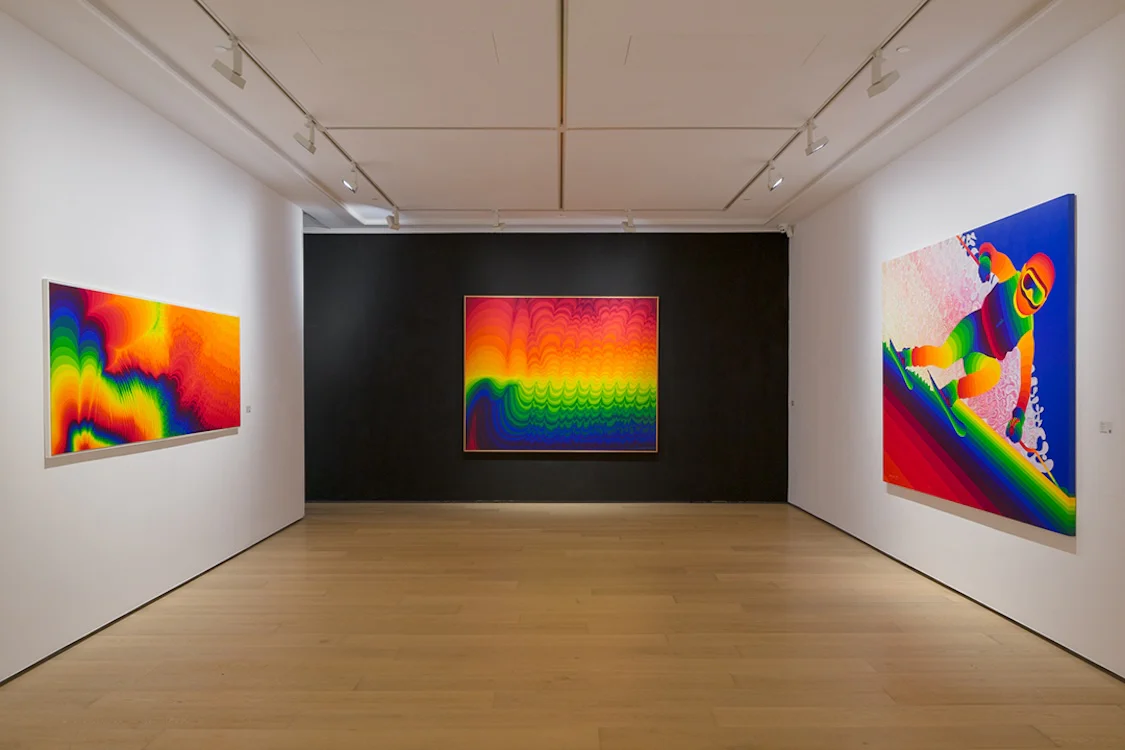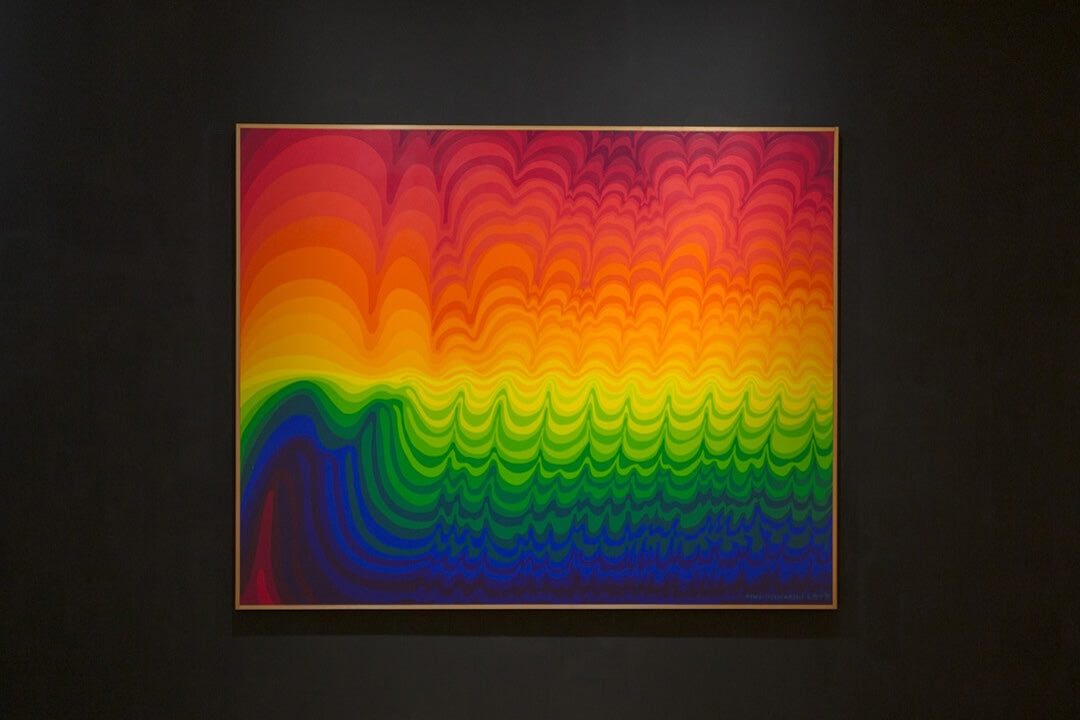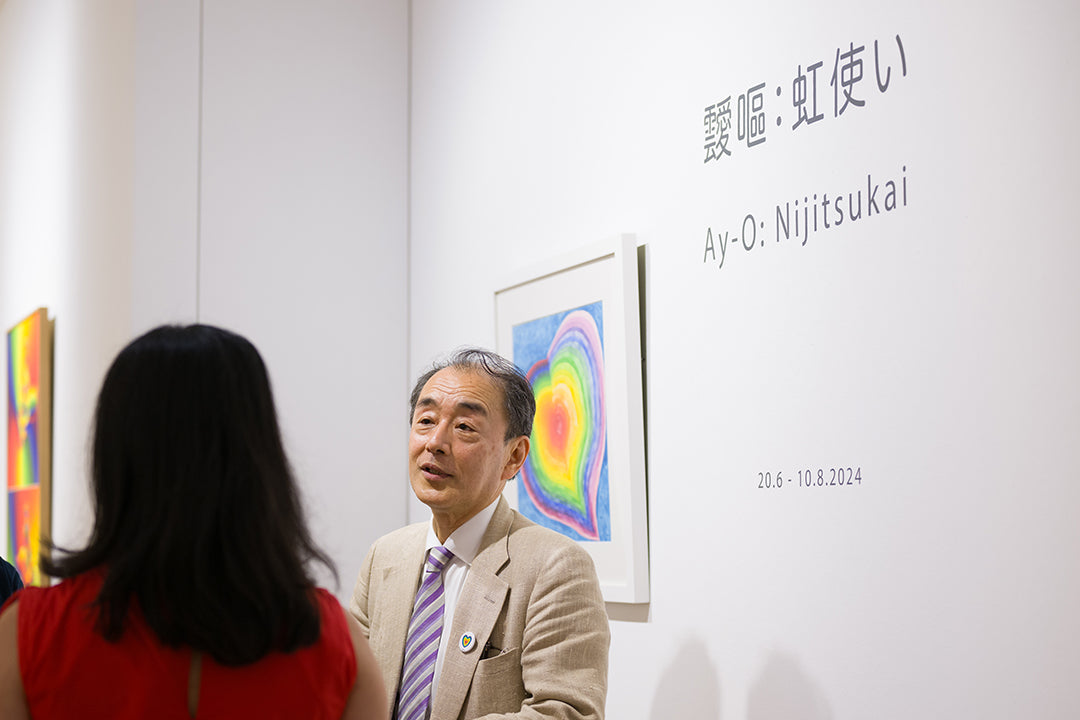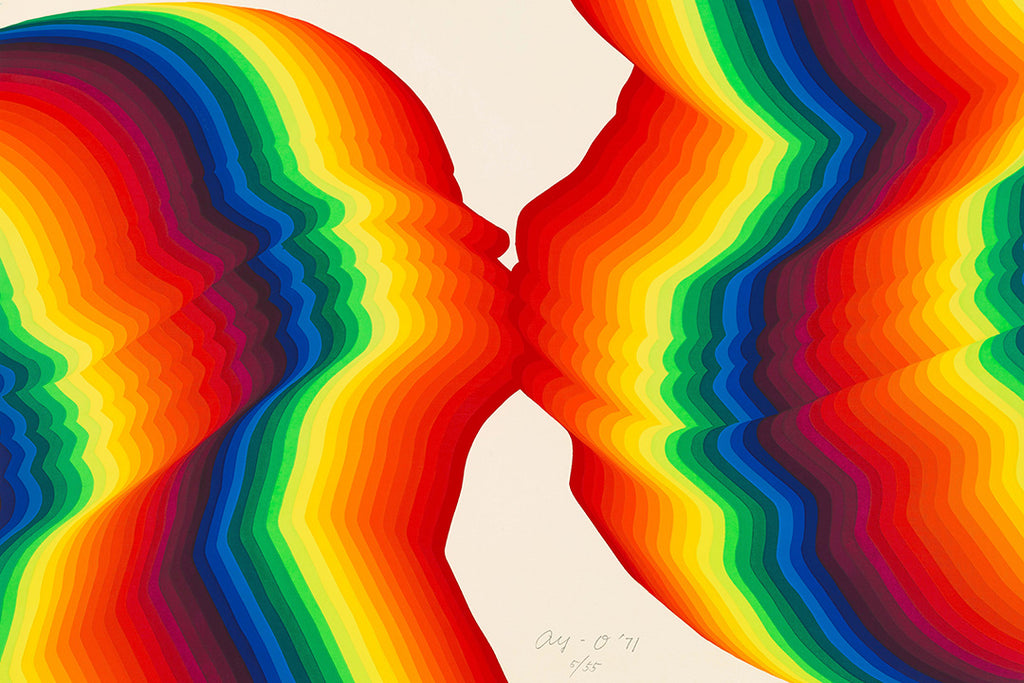ARTICLES
Ay-O: The Magic of Colors by the Rainbow Artist | Conversations with Ay-O
2024.06.28
INTERVIEW

Ay-O: Nijitsukai, Whitestone Gallery HK H Queen’s, 2024
Widely known as the "Rainbow Artist," Ay-O is celebrated for his masterful command of colors. His exhibitions have been successfully held at renowned museums such as the Smithsonian National Museum of Asian Art in the United States and the M+ Museum in Hong Kong, a testament of his exceptional presence in the art world.
Ay-O was born in Japan and flourished in the United States. Eiichi Matsuhashi, who has been personally in touch with Ay-O, shares their conversation about the artist's creative career.
About the Artist Ay-O
Eiichi Matsuhashi
Director of Karuizawa New Art Museum
First Encounter with Ay-O: Captivated by the Rainbow Artist

Ay-O: Nijitsukai, Whitestone Gallery HK H Queen’s, 2024
I first learned about Ay-O in 1983 through an article in the art magazine "ART VIVANT", published by the Seibu Museum. The issue featured Fluxus and included a talk. I was so impressed by the article, which brought the 1960s New York art scene to life. I have read it multiple times. The magazine also showcased numerous works from the Fluxus movement, which I could hardly believe my eyes upon gazing.
Later, I attended an intriguing event called "RAINBOW FRY" at a gallery in Omotesando, where various objects were tempura-fried. This is where I first met Ay-O in person. He was energetic, and I remember he said, "I'll do everything," and I realized that he really was a person who would do anything.
On another occasion, we had a meal together, and I asked him various questions:
"Is humor an important element in Fluxus art?"
"Yes, it is. You understand Fluxus very well."
"I learned Fluxus from reading Maciunas' (George Maciunas) book."
"Read my book too."
As a result, Fluxus brings humor into the context of art, challenging the seriousness of traditional art.
The Origin of Ay-O's Name: A Tale of Humor and Creativity

Ay-O: From Nijitsukai, “Those Who Go Spend Their Days and Nights Like This A,” 1998, 184.5 × 230.5 cm, Acrylic on canvas.
Interestingly, the origin of Ay-O's name was made as a prank. When he was a student, his friends let him decide his own name differs from their real ones. Iijima, which is Ay-O's family name, asked his friends to pick letters from the Japanese alphabet, ranging from A, I, U, E and O. At the end A, I, and O were chosen, while U and E were not. Thus, the name "Ay-O" was born when he was 22 in 1953.
At that time, Ay-O painted many clouds, so he chose the Kanji character "靉" (ai), meaning "cloud," and "嘔" (o), meaning "vomit", taken from the existentialist novel "Nausea" by Jean-Paul Sartre, resulting in the Kanji name "靉嘔" (Ay-O).
Although the name was created in a playful manner, Ay-O ended up using the alias throughout his life. I remember being surprised when, during a family gathering, his sister called him 'Ay-O' instead of his real name. It seemed that even among his family, this name had become more common than his birth name.
Ay-O and the Demokrato Artists Association: Transforming the Postwar Art Scene

Ay-O: From Nijitsukai, a series depicting the fairy tale of Urashima Taro.
It was in 1953, shortly after creating his name, Ay-O joined the Demokrato Artists Association following his graduation from university. When I asked him, 'What kind of group was the Demokrato Artists Association?' He replied, 'It was, you know, a very democratic group,' and I couldn't tell if he was joking or not.
However, looking back, unlike today where freedom is taken for granted. Back then, not long after the war, the concepts of freedom and democracy were fresh and new to hear. Taking these ideas in art practice must have been remarkable.
The Demokrato group allows members to engage freely and equally, regardless of their status or fame. The group's leader, Ei-Q, and the critic Sadajirō Kuboo provide unfaltering support to the group and opportunities for young artists like Ay-O and Masuo Ikeda to grow.
Ei-Q taught members on printmaking techniques, and Kubo organized print sale events in Fukui Prefecture to raise publicity for new artists, helping them to earn a living as professional artists. However, due to their commitment to Egalitarianism, the group eventually chose to dismiss.
Ay-O's Move to America: Inspired by Pollock and Duchamp

Ay-O: Nijitsukai, Whitestone Gallery HK H Queen’s, 2024
Subsequently, Ay-O made the bold decision to go to America, which was quite a daring move at the time. This was in 1958 when he was 28 years old.
When he was asked "Why America?" Ay-O responded: "Because Jackson Pollock and Marcel Duchamp are there."
By that time, Pollock had already passed away, but Ay-O often visited "Cedar Tavern", a bar where Pollock and other abstract expressionist artists gathered. It was said free meals were provided to artists who are moneyless.
Another artist Ay-O admired, Duchamp, was in New York, and Ay-O met him several times during Duchamp's solo exhibitions.
"What was it like meeting Duchamp?"
"Maybe because my English wasn't great, my encounter with Duchamp didn't require a lot of talking."
"So what did you do then?"
"I stayed silent. But I was happy."
In the late 1950s, legendary European artists who had fled from Europe were residing in New York. Besides Duchamp, Ay-O met several Dadaist and Surrealist artists. To Ay-O, this must have been a truly awe-inspiring time.
Throughout his time spent in New York, Ay-O immersed himself in trial and error.
Struggles and Creativity: Ay-O's Experimental Period in America

Ay-O: From Nijitsukai, Whitestone Gallery HK H Queen’s, 2024, on the left is "Rockaway Beach A" (1959), 76.0 × 117.0 cm, Oil, wood and mesh on canvas.
At that time in the 60s, abstract expressionism was the mainstream in the art world, many of which were based in New York, Ay-O's work holds to challenge the traditional norms of that painting style. As a result, his works didn't sell, and life was tough. Though ironically, a piece he painted that carries a satirical sense sold for a high price, allowing him to bring his wife over from Japan.
Still after that, his quest continued. Works during this period included "Rockaway Beach" (the piece on the left in the above image). He marked the completed work with an "X" as a denial to his abstract piece; he also created the work using discarded materials nearby.
The carpentry work he started for a living turned out to be a great addition to his art-making. As he worked with a variety of tools, art and living became one.
In an attempt to deny the traditional painting, he began making holes in canvases.This evolved into works with holes and led to the creation of the "Tea House," a work of art that can view art from a small room. The works created from this period, such as "Hydra," a large aluminum cylinder with smaller cylinders rotating when heated, were very unique and groundbreaking. This work garnered attention from young avant-garde artists and thus they paid a visit to Ay-O's studio.
His friend Yoko Ono brought many artists who would later become members of the Fluxus art movement. Allan Kaprow, the founder of Happening art,called Ay-O's work "Environmental Art."
Kaprow later included a photograph of Ay-O's "Hydra" in his acclaimed book "Assemblage,Environments & Happenings." It seems Kaprow provided a significant hint or insight.
Ay-O's Challenge to the Senses: Exploring Beyond the Five Senses

At the opening of the exhibition "Ay-O: Nijitsukai" in Hong Kong, recreating a Fluxus performance from the 1960s, including Nam June Paik’s work "One for Violin," with the author Matsuhashi breaking a violin.
He began creating works that related to all five senses—sight, hearing, smell, taste, and touch—as well as an unknown "sixth sense."
He initiated innovative projects including the Fluxus Orchestra, Rainbow Dinner Show, and works where perfume was sprayed from walls. Among these, his tactile art "Finger Boxes," designed to be appreciated through touch, was produced repeatedly in the subsequent years.
He later wrote, "I visited Jasper Johns' house and talked to him, but the happiest moment was seeing my Finger Box on his bookshelf."
There was another snippet about his tactile works. During a solo exhibition where he displayed pieces made of sponge (foam rubber), a man approached Ay-O and asked:
"Do you like things like this?"
"Yes, I do."
"Then I'll give you some."
A few days later, a truck stopped in front of his studio and delivered so many foam rubbers that filled the entire room. Ay-O created an environmental artwork where he buried himself in the sea of foam rubbers.
Ay-O's Visual Art: The Revolution of Rainbow Colors

Ay-O: From Nijitsukai, “Volcano” (1974), 241.0 × 173.0 cm, Acrylic on canvas.
The final sense is sight. For Ay-O, who started as a painter, this was the most important sense, yet also the most challenging realm.
A 15-meter canvas was rolled and stretched on a wooden frame around the studio. He painted the colors of the light spectrum on the canvas that was stretched across the walls of the room, painted in as many gradations as possible, from red to violet, the area that can be perceived by the human senses.
This visual environmental art, integrating all his previous efforts, resulted in a scientific painting unlike anything seen before. He wrote that when he conceived this idea, it felt as though he didn't have to paint it further as the visuals were completed.
Using the rainbow color sequence, Ay-O transformed everything into a rainbow.
In Japan, the rainbow is considered to have seven colors, but globally, it is composed of six colors. Ay-O's gradient paintings are scientific works that are strictly arranged in multiples of six. His subsequent success is well known to all.
In Greek mythology, King Midas was said to turn everything he touched into gold. Similarly, Ay-O transformed everything into rainbows. All visible things—past art, nature, animals, mythical figures, portraits, sports, still life and landscapes—everything was transformed into rainbows.
The world is transformed into Rainbow, and peace surrounds us.
This world, in which the 93-year-old artist lives, is surrounded by tragedies, wars and environmental crises. Will the dystopian world of rainbows manifest? Now is the time when Ay-O's work is much-needed. His art is still being unraveled, with new discoveries made every day.
I saw a sketch recently depicting plans to drape a rainbow flag from the Statue of Liberty in New York, a continuation of the Ay-O's rainbow flag event at the Eiffel Tower. Though this event did not take place, I am always amazed by fellow artists' boundless imagination and energy.

Eiichi Matsuhashi, from Ay-O: Nijitsukai, Whitestone Gallery HK H Queen’s.
Whitestone Gallery Online Store, Ay-O's works can be purchased directly from the website.

